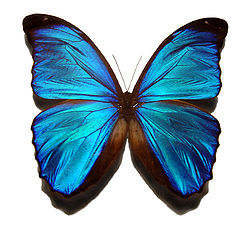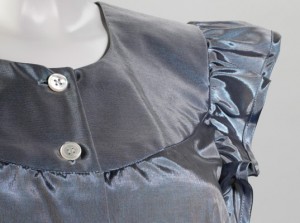I’m hoping one day they’ll be able to create textiles that rely on structure rather than pigment or dye for colour so my clothing will no longer fade with repeated washings and exposure to sunlight. There was one such textile, morphotex (named for the Blue Morpho butterfly, no longer produced by Japanese manufacturer Teijin but you can see a photo of the fabric which was fashioned into a dress by Australian designer Donna Sgro in my July 19, 2010 posting.
This particular project at the University of California at San Diego (UCSD), sadly, is not textile-oriented, but has resulted in a film according to a May 13, 2015 news item on ScienceDaily,
Inspired by the way iridescent bird feathers play with light, scientists have created thin films of material in a wide range of pure colors — from red to green — with hues determined by physical structure rather than pigments.
Structural color arises from the interaction of light with materials that have patterns on a minute scale, which bend and reflect light to amplify some wavelengths and dampen others. Melanosomes, tiny packets of melanin found in the feathers, skin and fur of many animals, can produce structural color when packed into solid layers, as they are in the feathers of some birds.
“We synthesized and assembled nanoparticles of a synthetic version of melanin to mimic the natural structures found in bird feathers,” said Nathan Gianneschi, a professor of chemistry and biochemistry at the University of California, San Diego. “We want to understand how nature uses materials like this, then to develop function that goes beyond what is possible in nature.”
A May 13, 2015 UCSD news release by Susan Brown (also on EurekAlert), which originated the news item, describes the inspiration and the work in more detail,
Gianneschi’s work focuses on nanoparticles that can sense and respond to the environment. He proposed the project after hearing Matthew Shawkey, a biology professor at the University of Akron, describe his work on the structural color in bird feathers at a conference. Gianneschi, Shawkey and colleagues at both universities report the fruits of the resulting collaboration in the journal ACS Nano, posted online May 12 [2015].
To mimic natural melanosomes, Yiwen Li, a postdoctoral fellow in Gianneschi’s lab, chemically linked a similar molecule, dopamine, into meshes. The linked, or polydopamine, balled up into spherical particles of near uniform size. Ming Xiao, a graduate student who works with Shawkey and polymer science professor Ali Dhinojwala at the University of Akron, dried different concentrations of the particles to form thin films of tightly packed polydopamine particles.
The films reflect pure colors of light; red, orange, yellow and green, with hue determined by the thickness of the polydopamine layer and how tightly the particles packed, which relates to their size, analysis by Shawkey’s group determined.
The colors are exceptionally uniform across the films, according to precise measurements by Dimitri Deheyn, a research scientist at UC San Diego’s Scripps Institution of Oceanography who studies how a wide variety of organisms use light and color to communicate. “This spatial mapping of spectra also tells you about color changes associated with changes in the size or depth of the particles,” Deheyn said.
The qualities of the material contribute to its potential application. Pure hue is a valuable trait in colorimetric sensors. And unlike pigment-based paints or dyes, structural color won’t fade. Polydopamine, like melanin, absorbs UV light, so coatings made from polydopamine could protect materials as well. Dopamine is also a biological molecule used to transmit information in our brains, for example, and therefore biodegradable.
“What has kept me fascinated for 15 years is the idea that one can generate colors across the rainbow through slight (nanometer scale) changes in structure,” said Shawkey whose interests range from the physical mechanisms that produce colors to how the structures grow in living organisms. “This idea of biomimicry can help solve practical problems but also enables us to test the mechanistic and developmental hypotheses we’ve proposed,” he said.
Natural melanosomes found in bird feathers vary in size and particularly shape, forming rods and spheres that can be solid or hollow. The next step is to vary the shapes of nanoparticles of polydopamine to mimic that variety to experimentally test how size and shape influence the particle’s interactions with light, and therefore the color of the material. Ultimately, the team hopes to generate a palette of biocompatible, structural color.
Here’s a link to and a citation for the paper,
Bio-Inspired Structural Colors Produced via Self-Assembly of Synthetic Melanin Nanoparticles by Ming Xiao, Yiwen Li, Michael C. Allen, Dimitri D. Deheyn, Xiujun Yue, Jiuzhou Zhao, Nathan C. Gianneschi, Matthew D. Shawkey, and Ali Dhinojwala. ACS Nano, Article ASAP DOI: 10.1021/acsnano.5b01298 Publication Date (Web): May 4, 2015
Copyright © 2015 American Chemical Society
This paper is behind a paywall.
For anyone who’d like to explore structural colour further, there’s this Feb. 7, 2013 posting which features excerpts from and a link to an excellent article by Cristina Luiggi for The Scientist.

